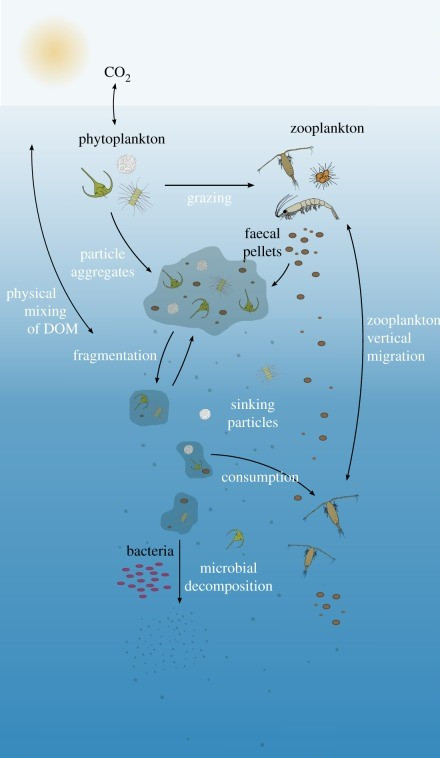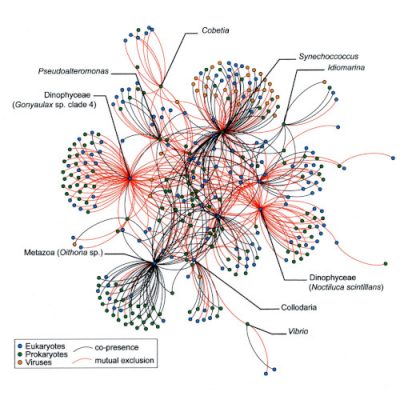The ocean’s biological carbon pump
PDFLucie Bittner, Lecturer in bioinformatics and evolutionary genomics at Sorbonne Université, Paris
Chris Bowler, CNRS Research Director, Institut de Biologie de l’École Normale Supérieure, École Normale Supérieure, Paris
A major question in marine biology is to identify which communities of organisms and genes are involved in carbon export in the nutrient-poor zones (so-called oligotrophic zones) that occupy over 70% of the oceans.
This question was addressed using an approach that integrates a maximum of heterogeneous data in order to understand an object in its entirety (systems biology) [1]. The objective was to explore the massive genomic data sets generated by the Tara Oceans expedition.

- the “physical” pump, which carries surface waters loaded with dissolved carbon dioxide to deeper layers where it is isolated from the atmosphere
- the “biological” pump, whose intensity is directly correlated to the abundance of certain planktonic species.
The deep ocean alone has stored one third of the CO2 emitted since the beginning of the industrial era. Figure 1 describes all the mechanisms that make up this pump [2]:
- the “biological” pump fixes carbon, either in the cells of phytoplankton via photosynthesis and heterotrophic zooplankton that feed on them, or in the shells or calcareous cell walls such as the scales of coccolithophores;
- In epipelagic waters, some of the carbon fixed in this way falls uninterruptedly with the faeces or after the death of the cells in the form of marine particles or “marine snow”.
- Two other important processes contribute to the transfer of carbon below the surface layer: physical mixing of dissolved organic matter (DOM) and transport by vertical migration of zooplankton.
- Once in the deep sea, the carbon is stored, known as sequestration.

The joint analysis of the marine environment (i.e. mainly carbon export values estimated for each sample from an on-board “Underwater Vision Profiler”) [3], and of the diversity of organisms and functions allowed the construction of a global co-occurrence network of genomic sequences and the extraction of sub-communities statistically and robustly linked to the biological pump of the oceans. This is the interactome of planktonic communities involved in carbon export.
Among these sequence communities detected are previously identified players, such as certain photosynthetic algae (especially diatoms) [4]. The hitherto largely underestimated involvement of certain microorganisms such as radiolarians[5]cyanobacteria and their viruses is renewing the current vision of the processes governing carbon export.
This study proposes new results and detects key sequences of the network, i.e. sequences of the network connection points, the “hubs”, and/or designated as the best statistical predictors of carbon export (Figure 2).
These sequences, corresponding to known or unknown microorganisms and/or functions, are ideal candidates for the development of biomarkers for monitoring the biological carbon pump. Knowing the structure of the genomic sequence networks involved in the biological pump opens up many prospects, including the possibility of fine-tuning the biological processes involved in the carbon cycle in the oceans. It should also be possible to test the robustness of these networks under different climatic conditions and to better understand how these different planktonic actors influence the carbon cycle and climate regulation.
Notes and references
[1] Guidi L., et al. 2016, Plankton networks driving carbon export in the oligotrophic ocean. Nature, 532:465-470.
[2] Benoiston A.-S., et al., 2017, The evolution of diatoms and their biogeochemical functions. Phil Trans R Soc Lond B Biol Sci, 372(1728).
[3] The Underwater Vision Profiler or UVP was developed to quantify the vertical distribution of macroscopic particles and zooplankton >100 µm in size. Picheral, M., Guidi L., Stemmann L., Karl D. M., Iddaoud G., & Gorsky G., 2010, The Underwater Vision Profiler 5: An advanced instrument for high spatial resolution studies of particle size spectra and zooplankton. Limnol. Oceanogr. Meth. 8:462-473.
[4] Herndl G. J. & Reinthaler T., 2013, Microbial control of the dark end of the biological pump. Nat Geosci. 6:718-724.
[5] Biard T., et al., 2017, Biogeography and diversity of Collodaria (Radiolaria) in the global ocean. ISM J. 11:1331-1344.




